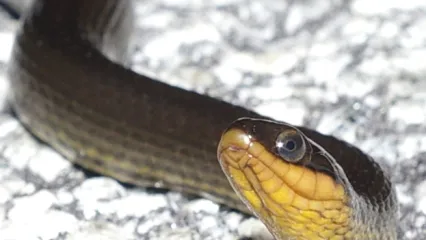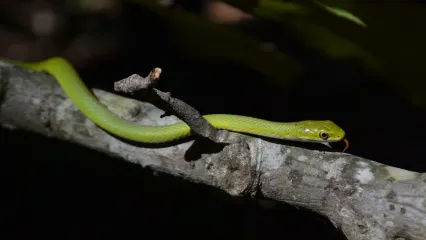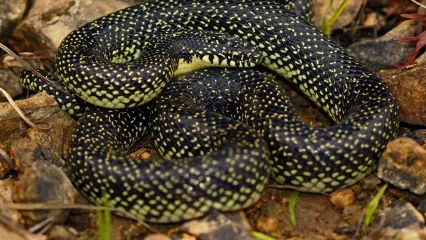
Description
The gulf crayfish snake is a dark brown to olive brown snake with heavily keeled scales. The body has a shiny appearance. The dorsal surface can have two narrow stripes on each side of the midline, but often these stripes are not evident. A distinct, light yellow stripe is apparent on the first scale row, which is an extension of the yellow coloration on the ventral scales. The lateral edge of each ventral scale abruptly changes to black such that a series of black oval-shaped spots run down each side of the ventral surface. These black markings widen on the throat producing wide single markings. The anal plate is divided. The underside and lateral surfaces of the head (including the upper labial scales) are yellow or cream. The eye is yellow to orange.
Size
Adult females reach slightly larger sizes than males and can reach 24 inches in total length. Typical adult size varies from 18-24 inches. Newly born offspring are about seven inches in length.
Habitat
The gulf crayfish snake is strictly aquatic. They are usually associated with swamps, ponds, boggy areas, streams, rivers and even roadside ditches. The Oklahoma distribution is restricted to the southeastern part of the state, largely the upper coastal plain. Because gulf crayfish snakes live in water where crayfish are common, their distribution is not continuous; rather it follows water courses. From west to east, the North American distribution extends from east Texas and Oklahoma (river systems) to the coastal plain of North Carolina. From north to south, the distribution extends from central Arkansas to the Gulf Coast and about halfway down the Florida peninsula.
Life Cycle
Most activity occurs at night, but they are active during the day as well, especially on rainy or overcast days. They feed mostly on crayfish, but occasionally eat frogs. Unlike Graham’s crayfish snake, gulf crayfish snakes prefer hard-shelled crayfish. Mating occurs during spring in the water. Gulf crayfish snakes are live-bearers, and females give birth to their young in late summer. The number of young varies with female size, with litters ranging from 6-14. Females reach sexual maturity at a size of about 17 inches in total length.
How To Observe
These are very difficult snakes to observe in the wild. They can occasionally be found crossing roads at night, especially during rainstorms, and they can also occasionally be found by turning surface objects along shorelines. Seining heavily vegetated swamps and ponds also can produce these snakes.
(This profile was created by Dr. Laurie Vitt as part of a partnership between the Wildlife Department and the Sam Noble Oklahoma Museum of Natural History. It was funded as part of a larger State Wildlife Grant to survey and inventory amphibians and reptiles of the Wildlife Management Areas of Oklahoma: T-35-P-1.)


